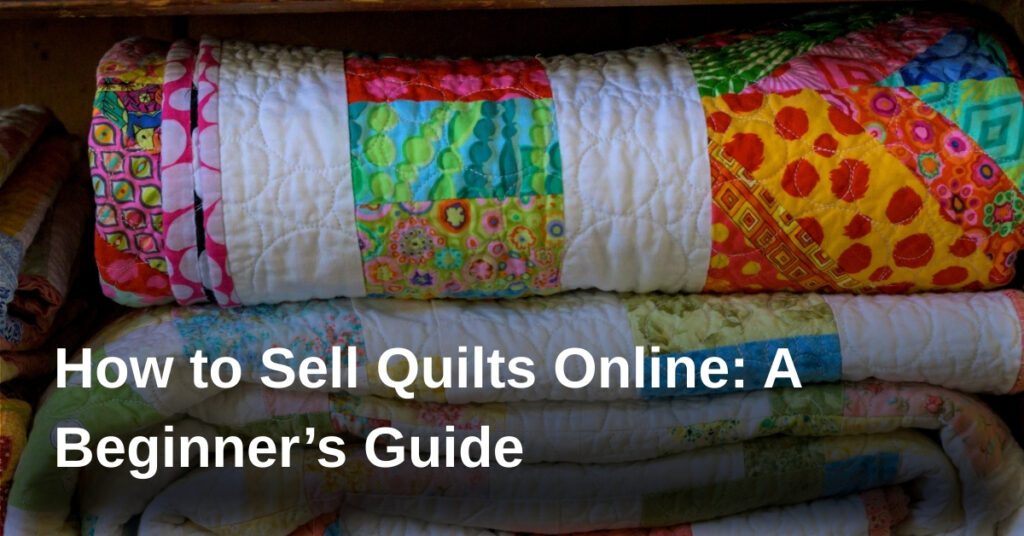
Quilting is more than just a craft—it’s a way to share creativity and comfort with others. In today’s digital age, many crafters want to sell quilts to a wider audience yet feel unsure about where to start. The process might seem daunting, especially when moving from local markets to online platforms. However, understanding how to create listings, connect with potential buyers, and present your work professionally can make all the difference. This guide aims to take the guesswork out, providing practical steps for beginners determined to turn their hobby into an online business. Whether you’re looking to showcase your best selling quilts or searching for the best place to sell quilts online, learning these basics will set you on the right path.
Main Points
To succeed in selling your quilts online, focus on several key areas. First, choose the most suitable platform—such as marketplaces or your own website—based on your goals and products. Prepare clear photographs and honest descriptions for each item to ensure buyers know what to expect. Price your work realistically by accounting for materials, time, and market rates. Consider shipping logistics, including packaging that protects your quilts and provides a pleasant unboxing experience. Finally, engage with customers by responding promptly to enquiries and gathering feedback, which helps build trust and improve your offerings.
Understanding the Online Quilt Market: Key Trends and Buyer Preferences
The online quilt market has grown considerably in recent years, reflecting both shifting buyer interests and evolving technology. People looking to Sell quilts online often notice unpredictable patterns in demand. Some customers gravitate toward classic designs, while others prefer modern interpretations or themed creations. Identifying the best selling quilts can be challenging, as popularity may shift due to changing color palettes or seasonal influences. Nevertheless, certain traits frequently attract buyers:
- Quality craftsmanship: Quilts with attention to detail tend to stand out.
- Unique patterns: Distinct styles hold lasting appeal.
- Personalization: Many shoppers appreciate made-to-order pieces.
Although the best place to sell quilts onli is often debated, established craft marketplaces generally provide visibility and built-in audiences. Still, private platforms or social media groups also have their merits. Navigating these choices requires flexibility and a willingness to adapt to trends.
You Can Also Review These:
How To Sell Quilts Online: 9 Small Business Tips – Like Sew
Choosing the Best Platforms to Sell Quilts Online
Deciding where to sell quilts online often depends on your specific needs and target audience. Some platforms cater to handmade and vintage goods, attracting buyers who appreciate the craftsmanship in every quilt. Others, however, offer a broader marketplace where visibility is higher, but competition can be tough. You might find that a dedicated craft platform offers a community feel and support, whereas large e-commerce sites provide sheer volume. There is no universal answer, yet understanding each site’s fee structure, policies, and user base is essential. Additionally, some sellers prefer using platforms that allow customisation of their store to reflect their brand’s personality. It’s worth noting that building a loyal customer base can be easier on niche platforms, although larger sites sometimes provide greater sales opportunities. Therefore, testing a few options can be particularly helpful as you work out the best place to sell quilts and grow your passion for quilting.
| Platform Type | Best For |
|---|---|
| Craft-Focused Sites | Artisan reach, community support |
| Large Marketplaces | High traffic, diverse buyers |
How to Price Your Quilts for Maximum Profit and Sales
Determining how to sell quilts for both profit and steady sales can be surprisingly complex. There’s no single formula, as prices often fluctuate depending on material costs, design intricacy, quilting time, and local demand. Therefore, researching similar sell quilts in your market offers a helpful starting point, but you should also factor in your unique style or specialty techniques. Some quilters add a markup for personalised touches or rare fabrics, which may appeal to certain buyers and justify a higher price tag. However, it’s essential to remain competitive; overpricing might drive potential customers away, whereas underpricing could undervalue your craft. Listing your sell quilts with transparent, fair pricing and sharing the story behind each piece can foster buyer trust. Experiment with different price points to gauge responses—sometimes small adjustments significantly impact not just profit, but also overall sales volume.
Crafting Compelling Product Listings with High-Quality Photos and Descriptions
Creating standout listings is key if you plan to sell quilts online. High-quality photos instantly draw attention—ensure lighting is natural and every detail is visible. When shoppers browse, they want to see stitching, patterns, and texture. Therefore, include various angles and a few close-ups. However, sometimes perfect photos can seem staged, so balance clarity with authenticity. Alongside visuals, focus on detailed descriptions. Mention dimensions, fabric materials, and care instructions. Yet, avoid endless technical jargon, as relatability matters. Potential buyers often wonder about a quilt’s story—why not mention inspiration behind certain color choices or patterns? Such details may not convert every visitor, but they help build trust. In my opinion, a great listing combines both factual information and emotional appeal. Remember, those seeking to sell quilts successfully often adapt their listings based on what their audience responds to.
- Photos: clear, well-lit, multi-angle views.
- Descriptions: informative yet engaging.
- Storytelling: adds uniqueness.
Building an Engaging Brand Story to Connect with Quilt Buyers
Crafting an authentic narrative is essential for anyone who aims to sell quilts effectively. Your story should reflect not only the unique qualities of your craft but also resonate emotionally with potential buyers. Frequently, customers look for more than just a product; they seek a connection to the maker and their journey. Hence, sharing thoughts about your inspiration, historical techniques, or family traditions can subtly set your brand apart. However, it’s not always about the grand gestures; sometimes, a simple anecdote about your creative process sparks interest in those wishing to sell quilts themselves. Additionally, your brand story offers a chance to gently convey your values, such as sustainability or supporting local artisans. The result is a community around your quilts, rather than just a transaction. Sell quilts not merely as items, but as stories waiting to be shared and cherished.
Promoting Your Quilts on Social Media and Craft Marketplaces
If you wish to Sell quilts online, building an engaging presence on social media is essential. Platforms like Instagram and Pinterest work particularly well for visually rich crafts, as stunning photos often attract more attention. Take advantage of natural lighting and showcase both finished pieces and the creative process. Storytelling can subtly engage viewers; sometimes, a small anecdote about a quilt’s inspiration prompts interest you might not expect.
“People buy quilts not just for warmth, but for the stories they tell and the care woven into every stitch.”
Additionally, joining craft marketplaces remains a tried-and-true way to Sell quilts. Choosing the right platform involves some experimentation, since different audiences frequent each site. Nevertheless, clear descriptions, honest pricing, and thoughtful packaging make a difference. Engage with your audience by replying to comments and sharing behind-the-scenes peeks. In many cases, combining social media with these marketplaces will help you Sell quilts more effectively.
Managing Inventory, Shipping, and Customer Service for Quilt Sales
Successfully running a quilt business often hinges on how well you manage Sell quilts logistics. Accurate inventory tracking helps you avoid both shortages and the hassle of overstock. Some makers use spreadsheets, while others prefer specialised apps—either way, having a clear overview is crucial for smooth Sell quilts operations. When it comes to shipping, offering a choice of local and international options can be appealing, although weighing the costs might seem tricky at first. Packaging also deserves attention, especially for delicate textiles.
Helpful Practices for Streamlining the Process
- Inventory check: regular stock reviews prevent accidental double selling.
- Clear policies: easy-to-understand shipping and return terms set proper expectations.
- Responsive communication: timely replies to queries encourage trust among buyers.
While there’s no single right way to manage these details, being proactive usually fosters customer satisfaction and repeat business in the Sell quilts market.
SEO Strategies for Increasing Visibility of Your Online Quilt Shop
To enhance your quilt shop’s online presence, it’s vital to focus on the right SEO strategies. Start by researching keywords potential buyers use, such as Sell quilts online, handmade quilts for sale, or custom quilt makers. These phrases should appear naturally in your product titles and descriptions. Adding blog posts with helpful guides or showcasing unique designs can also boost your rankings. However, not all content needs to be lengthy—sometimes, concise tips perform well, too. Meta descriptions matter because they entice searchers to click, yet many overlook this detail. Additionally, optimising image alt text helps search engines understand your products, although it’s easy to forget amid frequent updates. Linking internally between your shop pages improves navigation and keeps visitors engaged. Despite this, only consistent effort will bring lasting results. Use a mix of techniques and adjust as you learn what best helps you Sell quilts and reach new customers who want to Sell quilts themselves.
Leveraging Customer Reviews and Testimonials to Boost Quilt Sales
One often overlooked way to sell quilts more effectively is by showcasing genuine customer reviews and heartfelt testimonials. These written reflections do more than confirm the quality of your products—they build trust and foster a sense of community. Visitors browsing your site may feel uncertain about which quilt to choose, but when they read detailed experiences, their confidence tends to grow. Sometimes, a few words from a satisfied customer can be more persuasive than pages of product descriptions. Additionally, displaying high-quality photos shared by recent buyers may give potential customers new ideas or reassure them about their decision. While a glowing testimonial doesn’t guarantee every viewer will choose to sell quilts for you by word of mouth, it does increase credibility and can spark interest. Collecting honest feedback, encouraging reviews, and thoughtfully replying to customers can subtly set your business apart as you continue to sell quilts successfully.
Legal Considerations for Selling Handmade Quilts Online
Before you sell quilts on the internet, you’ll want to understand certain legal aspects. While requirements might seem straightforward, laws often differ depending on your country, state, or even city. It’s important to check if you need a local business license or seller’s permit, even if your quilting business is small or run from home. Taxes are another area to consider—collecting sales tax can feel confusing because online platforms may handle it for you, but not always. Additionally, your use of fabric and patterns could potentially raise copyright questions; many designers restrict how their materials are used in items for sale, so always review licensing details. To help you start, here’s a brief overview:
- Business registration: confirms if you need a formal license
- Sales tax collection: varies by region and platform
- Copyright clarity: ensures your quilts don’t infringe on anyone’s rights
Conducting some research beforehand can make selling handmade quilts much smoother and more secure for everyone involved.
Conclusion
Selling quilts online might seem daunting at first, yet with the right approach, it quickly becomes rewarding. By understanding your audience, presenting your work beautifully, and choosing the best platforms, you create real opportunities for your craft. Consistency and personal touch are vital because buyers value authenticity as much as quality. Therefore, as you learn and grow, don’t be afraid to experiment or ask for feedback. When done thoughtfully, to sell quilts online is not only possible but an enjoyable journey into turning your passion into profit.
Related Articles:
How to Sell Accessories Online: A Beginner’s Guide
